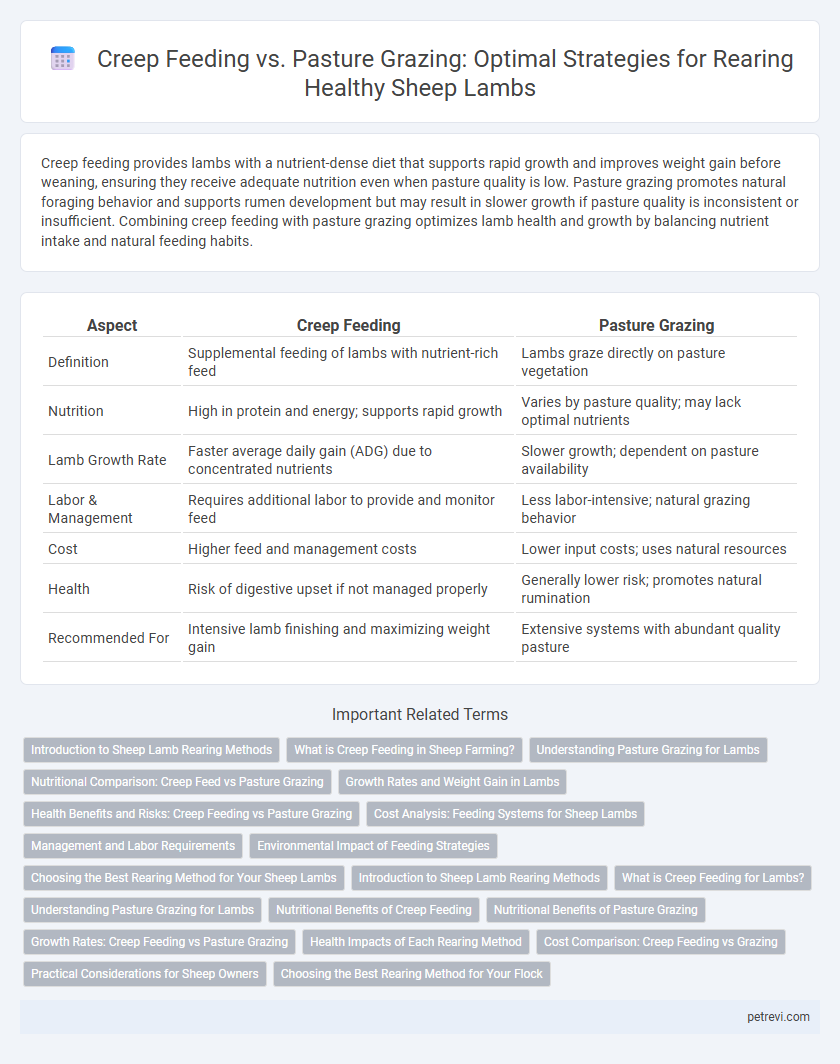Creep feeding provides lambs with a nutrient-dense diet that supports rapid growth and improves weight gain before weaning, ensuring they receive adequate nutrition even when pasture quality is low. Pasture grazing promotes natural foraging behavior and supports rumen development but may result in slower growth if pasture quality is inconsistent or insufficient. Combining creep feeding with pasture grazing optimizes lamb health and growth by balancing nutrient intake and natural feeding habits.
Table of Comparison
| Aspect | Creep Feeding | Pasture Grazing |
|---|---|---|
| Definition | Supplemental feeding of lambs with nutrient-rich feed | Lambs graze directly on pasture vegetation |
| Nutrition | High in protein and energy; supports rapid growth | Varies by pasture quality; may lack optimal nutrients |
| Lamb Growth Rate | Faster average daily gain (ADG) due to concentrated nutrients | Slower growth; dependent on pasture availability |
| Labor & Management | Requires additional labor to provide and monitor feed | Less labor-intensive; natural grazing behavior |
| Cost | Higher feed and management costs | Lower input costs; uses natural resources |
| Health | Risk of digestive upset if not managed properly | Generally lower risk; promotes natural rumination |
| Recommended For | Intensive lamb finishing and maximizing weight gain | Extensive systems with abundant quality pasture |
Introduction to Sheep Lamb Rearing Methods
Creep feeding involves providing supplemental feed to lambs while they remain with their ewes, promoting faster growth rates and improved weight gain. Pasture grazing relies on natural forage available in pastures, supporting lamb development through a more sustainable and cost-effective approach. Both methods have distinct impacts on lamb health, nutrition intake, and overall rearing efficiency.
What is Creep Feeding in Sheep Farming?
Creep feeding in sheep farming involves providing supplemental feed to lambs in a designated area inaccessible to ewes, promoting faster growth and improved weight gain before weaning. This method enhances nutrient intake by offering high-energy, digestible feeds that support optimal development during early life stages. Creep feeding can lead to better lamb survival rates and more uniform weaning weights compared to exclusive reliance on pasture grazing.
Understanding Pasture Grazing for Lambs
Pasture grazing for lambs promotes natural growth by providing access to diverse forage rich in essential nutrients like protein, fiber, and minerals critical for development. This method supports lambs' rumen development and immune system strength through exposure to varied plant species and natural grazing behaviors. Effective pasture management ensures optimal forage quality and availability, directly influencing lamb weight gain and overall health during rearing.
Nutritional Comparison: Creep Feed vs Pasture Grazing
Creep feeding provides lambs with a concentrated source of nutrients including higher protein, energy, vitamins, and minerals compared to pasture grazing alone. Pasture grazing offers variable nutrient intake depending on forage quality, which can fluctuate seasonally and affect lamb growth rates. Balancing creep feeding with pasture grazing optimizes lamb nutrition by ensuring consistent nutrient supply and improved weight gain.
Growth Rates and Weight Gain in Lambs
Creep feeding significantly enhances growth rates and weight gain in lambs compared to exclusive pasture grazing by providing high-energy, easily digestible nutrients that support rapid muscle and skeletal development. Lambs receiving creep feed typically exhibit a 15-25% increase in average daily gain (ADG), leading to heavier weaning weights and improved feed conversion efficiency. Pasture grazing alone, while promoting natural foraging behavior and health, often results in slower growth due to variable nutrient availability and forage quality fluctuations.
Health Benefits and Risks: Creep Feeding vs Pasture Grazing
Creep feeding lambs provides concentrated nutrients that support rapid growth and improved immune function, reducing vulnerability to parasites and nutritional deficiencies common in pasture grazing. Pasture grazing promotes natural foraging behavior and gut health through diverse forage intake, but risks exposure to internal parasites and variable nutrient availability. Balancing creep feeding with pasture grazing optimizes lamb health by ensuring consistent nutrient intake while maintaining natural grazing benefits.
Cost Analysis: Feeding Systems for Sheep Lambs
Creep feeding involves providing high-energy supplemental feed to lambs in a designated area, increasing growth rates but raising feed costs compared to pasture grazing. Pasture grazing relies on natural forage, minimizing input expenses but potentially resulting in slower weight gain and longer time to market. Cost analysis shows creep feeding can improve lamb performance and meat quality, offsetting higher feed expenses, while pasture grazing is more cost-effective in extensive production systems with adequate forage availability.
Management and Labor Requirements
Creep feeding in lamb rearing requires more intensive management and labor due to the need for daily feed preparation, monitoring intake, and maintaining feeding equipment, which can increase operational costs. Pasture grazing demands less direct labor but necessitates regular pasture management, such as rotational grazing and weed control, to ensure optimal forage quality and prevent overgrazing. Effective lamb growth depends on balancing these management efforts with available resources to maximize weight gain and overall flock health.
Environmental Impact of Feeding Strategies
Creep feeding for lambs increases feed resource use and waste production compared to pasture grazing, contributing to higher environmental footprints through intensified feed cultivation and transportation. Pasture grazing promotes natural forage consumption, reduces the carbon footprint, and supports soil health via nutrient recycling and vegetation cover. Sustainable grazing practices optimize land use efficiency and biodiversity, minimizing greenhouse gas emissions linked to concentrated feedlots.
Choosing the Best Rearing Method for Your Sheep Lambs
Creep feeding enhances lamb growth by providing high-energy, nutrient-dense feed that complements pasture grazing, especially during periods of low forage quality or scarcity. Pasture grazing promotes natural foraging behavior and supports rumen development, reducing feed costs while maintaining animal health with access to fresh forage. Selecting the optimal rearing method depends on pasture condition, lamb growth targets, and economic considerations, with integrated strategies often yielding the best outcomes.
Creep Feeding vs Pasture Grazing for Sheep Lamb Rearing Infographic

 petrevi.com
petrevi.com